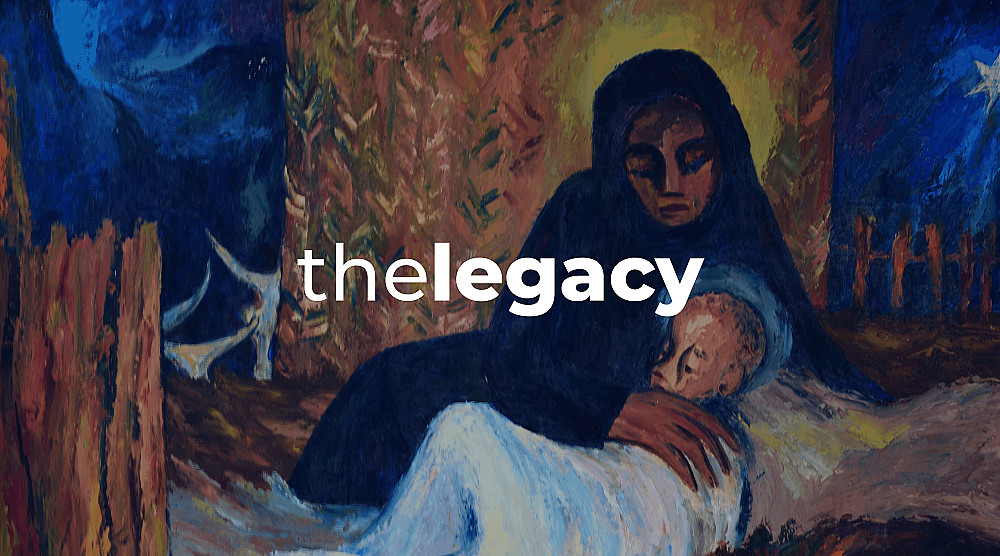Uche Okeke and the Dialogues That Shaped a Modern Nigerian Artist

Published 13 November 2025 in The Legacy
Uche Okeke Legacy Editorial
A Mind Formed in Conversation
To understand Uche Okeke, one must look beyond his drawings and linocuts. His work was forged in dialogue - conversations with writers, dramatists, historians, and fellow artists that challenged him to see art as both aesthetic form and cultural philosophy. For Okeke, ideas mattered as much as images. His intellectual life was a network of exchanges, carried out in cafés, classrooms, salons, and letters, and later distilled into his teaching and writings.
The Zaria Years: Founding Natural Synthesis
In 1958, Okeke was among the students at the Nigerian College of Arts, Science and Technology in Zaria who questioned the colonial curriculum that centered European art traditions. Together with Bruce Onobrakpeya, Yusuf Grillo, Demas Nwoko, and others, they formed the Zaria Art Society.
Their dialogue was not casual; it was pointed. They asked: What does it mean to be a modern Nigerian artist? Their collective answer was the doctrine of Natural Synthesis - a principle calling for the fusion of indigenous art forms with modern techniques. As Okeke later wrote, the artist must “draw from the past in order to create for the future.”¹
These conversations placed Uli, Nsibidi, and other indigenous systems not as decorative flourishes but as central elements of a new visual language. They also marked the beginning of Okeke’s lifelong project: art as cultural mediation.
The Zaria Art Society founding members
Mbari and the Crossroads of Literature and Art
After Zaria, Okeke moved to Ibadan and became involved with the Mbari Club, a crucible of post-independence creativity where writers, artists, and intellectuals gathered. Here he exchanged ideas with figures such as Chinua Achebe, Wole Soyinka, Christopher Okigbo, and John Pepper Clark
Achebe’s commitment to using English to tell Igbo stories resonated with Okeke’s effort to use modern media to express indigenous aesthetics. Soyinka’s engagement with Yoruba myth paralleled Okeke’s recovery of Uli. Okigbo, a poet who also trained in the visual arts, shared with Okeke a belief in the power of form to carry memory and rupture.
The dialogues at Mbari sharpened Okeke’s conviction that art must be socially engaged, intellectually rigorous, and rooted in lived cultural experience.
War, Silence, and Covert Exchanges
The civil war cut through these networks, but Okeke carried the logic of dialogue into the underground. In Enugu, his wartime salon gathered poets, dramatists, and visual artists in private rooms. Conversations turned to displacement, famine, and the possibility of cultural survival under siege.
Though few records survive, collaborators like Obiora Udechukwu later acknowledged that the workshops and exchanges he experienced during the war shaped his trajectory as a poet–artist. These wartime dialogues remind us that even in scarcity, intellectual life persisted.
Uche Okeke, War of Heaven and Earth (Igbo Folk Tale), Uche Okeke Legacy
Nsukka: Dialogue as Pedagogy
When Okeke took up the chair of the Department of Fine and Applied Arts at the University of Nigeria, Nsukka (1971–1983), he transformed his personal dialogues into pedagogy. His classroom was an arena of debate, where students were pushed to interrogate their heritage, experiment with traditional forms, and articulate new philosophies of modern art.
Figures like Obiora Udechukwu, El Anatsui, and Chike Aniakor emerged from these exchanges. They did not merely imitate Okeke; they argued with him, extended his theories, and found their own paths. This willingness to be challenged defined Okeke not only as an artist but as an intellectual mentor.
Writing as Dialogue
Okeke’s intellectual exchanges were not confined to spoken conversation. His anthology Art in Development: A Nigerian Perspective (1982; reissued 2019 by UOL and Iwalewa Books) collects essays, manifestos, and interviews spanning decades. It shows him thinking in dialogue with global modernism while anchored in Nigerian cultural forms.
In these texts, Okeke insists on the artist’s role as mediator: “The creative individual must serve as bridge between tradition and modernity, between community and the wider world.”² His writing makes clear that his art was never solitary; it was always part of a larger conversation.
Uche Okeke, Art in Development: A Nigerian Perspective, 1982; reissued 2019 by UOL and Iwalewa Books
Legacy of Conversations
Okeke’s legacy cannot be measured only in works of art. It resides in the dialogues he initiated and sustained - at Zaria, at Mbari, in wartime Enugu, and in the classrooms of Nsukka. His conversations with Achebe, Soyinka, Okigbo, Udechukwu, Aniakor, and others shaped an intellectual ecosystem that continues to influence Nigerian and African modernism.
The Asele Institute, which he founded, now holds the archives of those dialogues: sketchbooks, letters, lecture notes. These materials remind us that Okeke’s lines were never drawn in isolation. They were shaped, sharpened, and carried forward by the voices around him.
Notes
1. Smarthistory, “Uche Okeke,” https://smarthistory.org/uche-okeke
2. Uche Okeke, Art in Development: A Nigerian Perspective (1982; reissued 2019 by UOL & Iwalewa Books).
